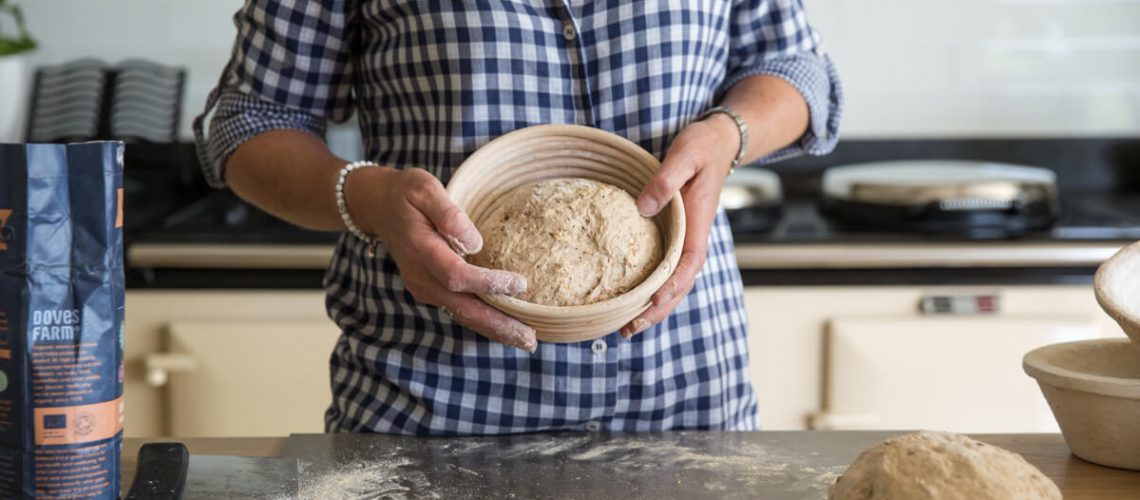

Judith Starling
Transforming your baking
NO KNEAD SOURDOUGH
What could be better than a bread that you don’t have to spend hours kneading?
INGREDIENTS:
- 250g active Pre-ferment fed with a mixture of strong flours (half wholemeal, half white for example) – See 1)
- 275g water – it’s best to weigh this as opposed to measuring it in ml as it is more accurate
- 500g flour (either all strong white flour or 400g of strong white flour and 100g of strong wholemeal, rye, spelt or Khorasan flour)
- 1 1⁄4 tsp salt
1) At lunchtime on the the day before you want to bake your loaf, take your starter out of the fridge and feed it with 50g of strong flour (25g white and 25g wholemeal) and 50g of water. Cover it with clingfilm and leave it for the rest of the day at room temperature to become active again. In the evening you should see that it has either risen or that bubbles are forming on the surface (or both). Now put it in a bowl and add 140g of strong flour (70g white and 70g wholemeal) and 110g of water. It should have a fairly thick consistency, so that it does not slide off a wooden spoon easily. Cover the bowl with cling film and leave it overnight. In the morning it should be clearly fermenting – thick, sticky and bubbly. This is your Pre-ferment.
2) Take 250g of the Pre-ferment out of the bowl and put the rest (no need for more than 150g though) into a clean Kilner jar and back into the fridge. This is your starter for next time. If there is more preferment left over in your bowl, spread it thinly onto baking parchment and let it air dry – this is a nice backup if you have any mishaps with your “wet starter” in the fridge! You can store the flakes in a little jar (or zip lock bag) indefinitely and follow the instructions above on reactivating it if you need to.
3) You can now either proceed by hand or use a food processor with a dough hook (as I often do). Mix the 500g of flour (see above) and the 275g of tepid water until all the water has been absorbed by the flour, cover it and leave it alone for between 20-60 minutes (this is called “autolysing”) before adding the other ingredients (250g of Pre-ferment and 1 1⁄4 tsp of salt) and mixing it all really well. You can now also add a small handful of seeds (pumpkin, sunflower sesame, etc) if you fancy. If you don’t have time for the extra step of autolysing, just mix up all the ingredients straight away. Once all the ingredients have been combined, you have your Final Dough.
4) When you are happy that the Final Dough has been well mixed, lightly oil a big bowl with a bit of sunflower oil and put the Final Dough into it (the oil is optional but it makes getting the Final Dough out of the bowl later easier). Cover with lightly oiled cling film (or a big polythene bag or shower cap) and leave for 5-6 hours at room temperature (assuming this is not above, say, 21 degrees C – on hot days, you will need to reduce this time to prevent overproofing). (Alternatively, you could combine your Final Dough in the morning and leave it in a fairly cool place all day, or mix it in the evening and leave it to somewhere cool to rise overnight.) You want the Final Dough to rise noticeably in the bowl. Your dough won’t whoosh up to twice its size in an hour like a conventional loaf with commercial yeast does. Sourdough is a wild, living thing and how long this stage takes depends on a number of things: the temperature of your kitchen, activity levels of your starter, the strain of yeast in your sourdough starter, humidity, to name a few. Sourdough rises slowly and sedately. Don’t expect it to double in size – a rise of 50% or so is fine.
5) Once it has risen, ease the dough out of the bowl with your dough scraper onto a floured surface, trying not to deflate it too much. Take a corner of the dough and fold it over into the middle, pressing it down to stop it unraveling again. Rotate the dough by a quarter and take the next corner and fold it into the middle, pressing it down before rotating the dough again and continuing this motion. Continue to form a ball with the dough by doing this for a number of rotations. You are trying to achieve surface tension on the outer skin of the Final Dough. If you are unsure about this stage, do have a look at dough shaping videos on YouTube if you have access to a computer. Your shaped dough is now ready for proving. Flip it over (so it is seam side down) and rest it for a minute while you prepare your proving basket/banneton.
6) To prepare your banneton, dust it heavily with flour. To season a new banneton, I use rice flour or any other gluten free flour to avoid the dough sticking when you tilt it out later. Place your ball shaped dough inside, SEAM SIDE UP and cover it again with lightly oiled cling film or a large polythene bag. Leave it to rise, at room temperature or a slightly warmer place for 1-3 hours, until it has risen in the proving basket. Again, you are not looking for it to double in size. A 30% rise here is fine or you will overproof! Alternatively, you can put your dough into the banneton, cover it with clingfilm and put it into the fridge at this stage (as soon as you have put the dough into) and bake the loaf at some point the next day, straight from the fridge without having to let it come to room temperature first.
7) If you have a baking steel or stone, put it into the middle section of your oven and preheat your oven to 250C (or as hot as it will go), for at least 30 minutes. You can use a baking tray if you don’t have a steel but I recommend getting one for the best results. I bake in a conventional oven so you need to adjust the temperatures downwards slightly if you are going to bake in a fan-assisted oven. Just before you are ready to bake, place a shallow ovenproof dish with boiling water into the bottom of your oven. This is to create a steamy atmosphere which allows the crust of your loaf to form slowly, therefore becoming lovely and chewy, and allowing the dough to rise.
8) When you are ready to bake, remove the cling film from the proving basket, upturn the dough onto some baking parchment and slide onto the baking steel or tray (the loaf is now SEAM SIDE DOWN).Make a couple of quick slashes, an inch in depth, onto the top of the loaf with a sharp, serrated knife (a bread knife works best for this).
9) Bake your loaf at 250C (or thereabouts) for 10 minutes and then turn the oven down to 190C and bake for another 35-40 minutes. Ovens vary greatly so watch your loaf and adjust the timing or temperature to achieve the desired colour on the top of your loaf. Add an extra 10 minutes at a slightly lower temperature if you proofed your loaf in the fridge overnight. Rest your loaf on a wire rack when you take it out of the oven (it should sound almost hollow when you tap the underneath) and let it cool down almost completely before cutting into it.

